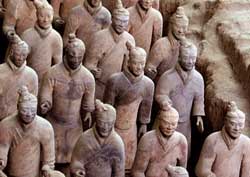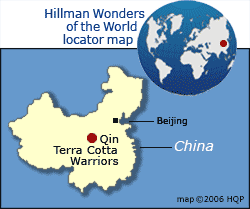Terra Cotta Warriors
 Why the
Qin Terra Cotta Warriors
in China are special
Why the
Qin Terra Cotta Warriors
in China are specialThe Qin Terra Cotta Warriors site near Xi'an city has nearly 8,000 life-sized pottery warriors and horses in battle attire and formation. They had been buried for over 2,200 years.
This terra cotta statuary is considered to be the most important archaeological discovery of the 20th century.
Origin
Why they were created
The pottery warriors and horses (along with wooden chariots) were buried to protect the 3rd century BC Emperor Qin in his afterlife. He is historically important because he was the first ruler to unite China.
Discovery
1974
The site was discovered accidentally in 1974 when several local peasants were digging a well and came across some pottery relics. Archaeologists quickly determined their ancient origin and began excavating the site.
Underground chambers
So far, four have been unearthed
-
Vault #1
This is the main and largest. It houses 6,000 life-sized terra cotta warriors (see photo). Originally, they were colorfully painted. The underground combat-ready soldiers are accompanied by sculpted horses, chariots and more.
- Vault #2
Smaller with less statuary
- Vault #3
Even smaller.
- Vault #4
Found empty.
Pronunciation
The word Qin is pronounced ch'in (rhymes with tin).
Popular destination
Over 80 million people have visited the museum complex since it opened to the public a quarter century ago.
How they were made
The warrior statues are hand made and assembled in parts. The heads were the last to be attached and received the most artistic attention. Each warrior bears a unique facial expression, suggesting that live models were used.
Height and weight
The pottery human figures average 1.8 meters (six feet) in height. Their weight range is about 100 to 300 kilograms (220 to 660 pounds).
Nearby mound
Emperor Qin is believed to be buried under an enormous earth mound about 1.5 kilometers (1 mile) from the terra cotta warrior site.
Archaeologists have yet to excavate it. Ancient writings hint that Qin's mausoleum may contain a wealth of artistic treasures, more striking and precious than those found in King Tut's tomb.
Location in China



